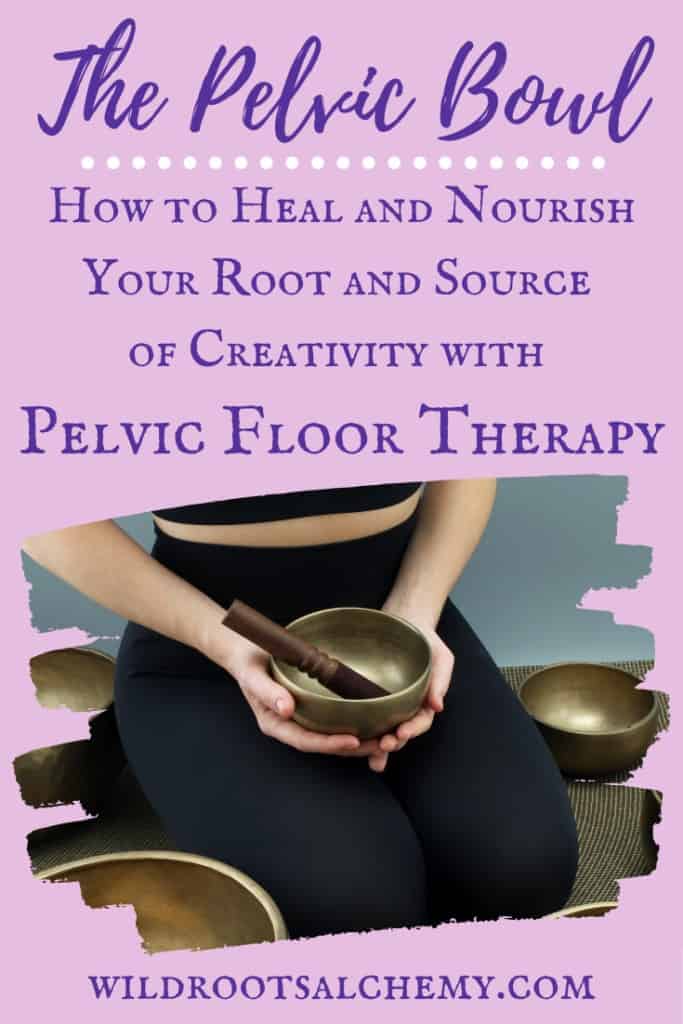
So many females suffer from chronic pelvic pain, painful periods, or painful intercourse. Many females have also suffered from some sort of trauma to their root, whether that was surgical, sexual, or emotional trauma. A feeling of disconnect often ensues following trauma—a numbness, a certain amount of detachment—that freezes the root of our being in order to protect it, disconnecting us from that part of ourselves that energetically roots us into the Earth and is the source of our abundant creative power: our pelvic bowl.
What is a Pelvic Bowl?
Physically, your pelvic floor consists of a group of muscles, ligaments, and fascia in your lower pelvis, shaped like a bowl. Your pelvic bowl provides support to your pelvic organs—including your bladder, uterus, vagina, and intestines—and is also involved in maintaining your posture and breathing. Due to the bundles of nerves that run through the pelvis, the supporting structures of the pelvic bowl are an important part of sexual sensation and the healthy functioning of the pelvic organs.
In a holistic approach, your pelvic bowl is so much more than the bodily organs it cradles. Just like a physical congestion of blood and lymph flow through the pelvis can impair the healthy functioning of the pelvic organs, a disruption of the flow of vital energy can lead to dis-ease in the pelvis.
Energy gets stuck in our pelvis when there is a blockage between our root and the rest of our body—namely, our heart. Trauma or grief can disrupt our connection to our root so that energy stagnates, leading to a number of symptoms.
Actually, chronic psychospiritual or energetic imbalances often express themselves with physical symptoms. That’s how our wise bodies communicate to us when something is out of alignment with our inner nature!
Our Root: The Source of our Creative Power

Our roots nourish us like the roots of a tree and they have the amazing ability to nourish new human life. While our wombs can be physical sources of creation, they also serve to provide us with the power to create what we want in our lives.
If energy is stuck in our pelvic bowls, we can feel lethargic, depressed, and unable to move forward in life or regularly experience the joy of creating. We can actively cultivate our creative abilities by consciously focusing on what brings us joy, tap into our curiosities and passions, and discover how we can create these feel-good feelings in our own lives. Doing this intentional work helps nourish our connection to our root, and so does physically working with and engaging the pelvic floor structures.
Physical Pelvic Floor Dysfunction
On a physical level, the term “pelvic floor dysfunction” refers to a condition that results from an imbalance in the muscles of the pelvic bowl, where the muscles are not engaging properly and are either too weak or too tight.
What causes pelvic floor dysfunction?
- Pregnancy and childbirth
- Pelvic surgery or trauma
- A history of pelvic infections (chronic yeast or bacterial infections, pelvic inflammatory disease)
- Chronic constipation
- Heavy lifting
- Poor posture
How Pelvic Floor Therapy Helps to Heal and Nourish Your Root
Holistic pelvic floor therapy is designed to help you reconnect to your root and work through stored traumas while moving stagnant energy through the pelvis. It also physically addresses muscular imbalances that lead to pelvic pain, urinary issues, organ prolapse, and other symptoms of pelvic floor dysfunction.
Pelvic floor therapy is a combination of internal (intravaginal) manual therapy techniques and physical exercises designed to address pelvic floor dysfunction and treat the root cause of pelvic conditions. A pelvic floor therapist will identify your areas of muscular imbalances and use manual techniques to encourage relaxation of tight muscles, and will offer specific exercises to engage and strengthen weak muscles, focusing on coordination throughout the pelvic bowl. Postural exercises and other at-home exercises are typically prescribed to help maintain the therapy’s effects and improve the tone of the pelvic floor musculature.
During a holistic pelvic floor therapy session, you may also utilize breathwork, visualizations, and meditation to tap into the energetic and emotional healing work that is often incredibly beneficial and necessary for healing.
A fully holistic approach to pelvic floor health goes far beyond a Kegels prescription: it involves specific relaxation and strengthening exercises, postural changes, and often an exploration of your emotional connection to your pelvic bowl.
Who Can Benefit from Pelvic Floor Therapy?
The answer is almost everyone, even males. In a society that is increasingly disconnected from the natural world and shares a great deal of collective trauma, we could all benefit from healing our root. With that being said, pelvic floor therapy can be especially helpful for the following conditions:
- Chronic pelvic pain
- Endometriosis
- Painful menses
- Painful sexual intercourse
- Urinary issues: incontinence, frequency, interstitial cystitis, chronic urinary tract infections
- Vulvodynia
- Vaginismus
- Bowel dysfunction: constipation, incontinence, painful bowel movements
- Pelvic organ prolapse
- Sacroiliac joint, lumbar, coccyx, and hip joint pain
- Postpartum recovery
- Post-hysterectomy recovery
- History of traumatic experiences associated with the pelvic area
Interested in working with a holistic pelvic floor therapy practitioner? Check out my clinic’s website to see if I can help you! If you don’t live near me, please feel free to send me a message and I can help you connect with a pelvic floor therapist in your area.
Feel free to comment below with your experiences with pelvic floor therapy!
Photo in featured image courtsey of Magicbowls from Pexels.





